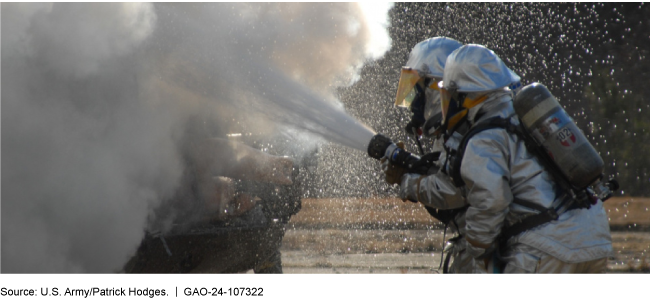Firefighting Foam: DOD is Working to Address Challenges to Transitioning to PFAS-Free Alternatives
Fast Facts
The Defense Department is required to transition away from using firefighting foam that contains PFAS, a class of chemicals that poses health risks and has been found in drinking water around bases. This kind of foam has been considered the most effective product for suppressing jet fuel fires.
The military departments have identified challenges that may slow the transition. These include:
Lack of a drop-in replacement that, for example, can be mixed with water in advance and works in the same firefighting systems
An estimated transition cost of more than $2.1 billion
DOD expects to seek waivers for upcoming transition deadlines.
Firefighting foam forms a “blanket” over liquid fuels that prevents flammable vapors from escaping

Highlights
What GAO Found
The Department of Defense (DOD) has taken steps to eliminate use of aqueous film-forming foam (AFFF)—a product used to fight flammable liquid fires—at its installations. AFFF contains per- and polyfluoroalkyl substances (PFAS), which may have adverse effects on human health, including effects on fetal development, the immune system, and the thyroid. Also, PFAS may cause liver damage and cancer. The National Defense Authorization Act for Fiscal Year 2020 required, in part, that DOD discontinue use of AFFF at its installations after October 1, 2024—with waivers possible until October 1, 2026, and an exemption for shipboard use. The military departments have developed implementation plans, schedules, and costs for replacing AFFF in all land-based mobile assets and facilities worldwide. Further, DOD has developed specifications for the development of a fluorine-free foam that provides a PFAS-free alternative for meeting DOD's fire extinguishing performance standards.
Firefighters Train to Extinguish Aircraft Fires

The military departments have identified challenges that may affect the time and resources required to fully eliminate AFFF at DOD installations. For example:
- There are several compatibility issues with qualified fluorine-free foams that preclude them from being drop-in replacements for AFFF for certain tactical firefighting systems, such as their inability to withstand certain temperatures or to be mixed with water in advance of use.
- There are substantial funding requirements for the transition from AFFF to a fluorine-free product—initial estimates stand at over $2.1 billion.
- DOD firefighters are not fully trained in use of fluorine-free foams, which differs from use of AFFF.
In February 2024, DOD reported to Congress that it anticipates needing to submit the two allowable 1-year waiver requests to the October 1, 2024, statutory deadline—extending some AFFF use at DOD installations to October 1, 2026. The extensions are primarily due to the time it takes to transition systems from AFFF to fluorine-free alternatives without compromising missions or safety.
Why GAO Did This Study
DOD uses AFFF in about 1,500 facilities and over 6,800 mobile assets worldwide to suppress fires. Release of AFFF into the environment, either through accidental releases, or for fire training and emergency use, has resulted in PFAS detections in drinking water and groundwater in and around DOD installations. In recent years, various statutes have been enacted to limit DOD's use of PFAS-containing materials, including AFFF.
GAO was asked to review issues related to DOD's transition to PFAS-free alternatives to AFFF. This included the extent to which DOD has (1) taken action to discontinue use of AFFF at DOD installations and (2) identified challenges that may affect its ability to meet statutory deadlines for discontinuing use of AFFF.
GAO reviewed relevant statutes and examined DOD and military department documents and policies related to use of and transition from AFFF. GAO also interviewed officials from the Office of the Assistant Secretary of Defense for Energy, Installations, and Environment; the military departments; and other agencies responsible for implementing the AFFF transition.
DOD provided technical comments on a draft of this report, which GAO incorporated as appropriate.
For more information, contact Alissa H. Czyz at (202) 512-3058 or czyza@gao.gov.
